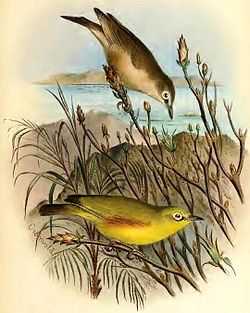Seychelles White-eye
| Seychelles White-eye | |
|---|---|
 | |
| Seychelles White-eye above | |
| Conservation status | |
| Scientific classification | |
| Kingdom: | Animalia |
| Phylum: | Chordata |
| Class: | Aves |
| Order: | Passeriformes |
| Family: | Zosteropidae |
| Genus: | Zosterops |
| Species: | Z. modestus |
| Binomial name | |
| Zosterops modestus (E. Newton, 1867) | |
The Seychelles White-eye (Zosterops modestus) is a rare warbler-like perching bird from the family of white-eyes (Zosteropidae). It is endemic to the Seychelles.
Description
This ten to eleven centimetre long bird has a plumage with olive grey upperparts and dull coloured underparts. It is further characterized by a white narrow eye-ring, a rather long dark grey tail and a small sharp bill. Its diet consists of insect larvaes, locusts, and grasshoppers as well as berries and seeds. The breeding season is from September to April and a clutch of two to seven eggs is laid into a cup-shaped nest. The incubation time is thirteen to fifteen days and the young are fully fledged after eleven to sixteen days. After that the parents are looking after them another two months. Its melodious and complex song consists of nasal tones. Due to its ecology and foraging in the canopy of high trees it is difficult to observe.
The existence of an amazingly complex cooperative breeding system was discovered among Seychelles White-eyes. It is apparently unique among all species of white-eyes and appears as a very peculiar social breeding organisation among birds in general. Within the same breeding territory, the individual composition of nesting groups constantly changes, often involving birds that sometimes also contribute to nests in other territories.[citation needed]
Threats
It was thought to be extinct between 1935 and 1960 until it was rediscovered in the highland of Mahé. Even in 1996 it was considered as one of the rarest birds in the world with a population of only 25 to 35 individuals. The dramatically decline was caused by the extensive forest clearings and the competition especially from Common Myna and rat predation. In 1997 came the discovery of about 250 individuals on the Seychelles island of Conception. In 1998 the population on Mahé was estimated to be abouto 50. Currently the population on Conception Island consists between 244 and 336 individuals. In 2001 Island Conservation Society led a project to transfer 31 birds to the Seychelles island of Frégate. The population has since increased to more than 60 birds. Further transfers of birds have made to North Island, Seychelles and to Cousine Island.
References
- ↑ BirdLife International (2012). "Zosterops modestus". IUCN Red List of Threatened Species. Version 2013.2. International Union for Conservation of Nature. Retrieved 26 November 2013.
External links
- Seychelles White-eyes transferred to North and Cousine (Engl.)
- Seychelles White-eyes on the move (Engl.)
- Seychelles White-eyes news (Engl.)
- Island Conservation Society
